Advection and Trophic Subsidies

The world’s open ocean appears barren, but is it its low productivity, transported by currents, what fuels the rich ecosystems along shelves and coasts?
The open ocean, often regarded as a marine desert due to its low per-area productivity, harbours between 1–16 billion tonnes of small mesopelagic fishes, roughly the size of a finger. These fish, inhabiting the twilight or mesopelagic zone, are estimated to comprise 50–95% of the global fish biomass, likely making some of them the most abundant vertebrates on Earth.
Numerous predators, including birds, fishes, squids, seals, and even baleen whales rely on vision—and thus light—to locate their prey. In the open ocean, the rapid attenuation of light with depth provides essential cover from visual predators. Many mesopelagic fish, along with pelagic crustaceans, squids, and gelatinous zooplankton, remain hidden in the twilight zone at depths of several hundred meters during the day. At dusk, they migrate to surface waters to feed under the cover of darkness, returning to the depths at dawn.




Mesopelagic ecosystems have primarily been studied for their vertical connections between surface waters and the deep sea, focusing on sinking particles and vertical migration. However, there is a bias, with little attention given to how this vast biomass moves horizontally or integrates into the food chains of nearby, shallower ecosystems.
Small and scattered across vast ocean volumes, mesopelagic organisms often drift passively with currents, much like plankton. Advection effectively transforms ocean currents into food conveyor belts, delivering vast amounts of prey to distant feeding hotspots where thriving ecosystems emerge, thus ecologically linking systems distant in space and time.

We hypothesize that advected prey from the open ocean subsidize local production in shelf seas at a much larger scale than currently acknowledged and that this represents an overlooked yet significant explanation.
Being widely dispersed and hard to locate, the organisms inhabiting the twilight zone are difficult for predators to feed on. However, advection into shallow waters forces them into the light and brings them within reach of bottom-dwelling predators lining the upstream flanks of banks, seamounts, islands, shelf breaks, or underwater canyons, forming a “wall of mouths,” much like mussels filtering food from passing currents (see number one on figure below)
Unlike upwelled nutrients, which require time to stimulate phytoplankton growth and for energy to propagate through the food web, advected prey immediately supports local predator populations.



This may explain why regions such as the marginal ice zone, seamounts, and shallow banks attract high densities of predators. These are areas where prey that normally remain hidden in the dark are first exposed to light: (1) when prey is washed into shallow areas where the seafloor prevents escape into deeper and darker waters (Langbehn et al., 2023); (2) when prey is flushed from the darkness beneath sea ice into sunlit open ocean (Langbehn et al., 2023; Langbehn & Varpe, 2017); and (3) when prey is carried by currents into high-latitude areas during summer, when day-night cycles fade into the midnight sun with continuous daylight (Langbehn et al., 2022; Ljungström et al. 2021).


Approach and research questions ❯
The project is organized into three interconnected work packages (WPs), each addressing a central research question with a distinct methodological approach: Each WP is divided into specific tasks with clearly defined outcomes and milestones. While the WPs will start sequentially, they will progress in parallel, creating an iterative feedback loop of modelling-observation-modelling where data and insights from each WP inform and refine the others. This structure ensures a rigorous, systematic investigation, adhering to the principles of strong inference (sensu Platt 1964).

Fieldwork ❯
As part of the project we have planned a multi-week research cruise on board the RV G.O. Sars to gather biological, oceanographic, and acoustic data, focusing on benthopelagic interactions around the Faroe Plateau. This region's unique topography and its position between major ocean currents make it an ideal location for studying the dynamics between advected prey and stationary predators. We will perform cross-shelf transects on both the windward and leeward sides of the plateau, capturing a range of hydrographic conditions. This approach will help us understand how advection influences marine communities and quantify the energetic subsidies provided by advected prey. Additionally, we will analyze fisheries data and a time series of ADCP ocean current data, comprising over 200 years of observations aggregated from multiple devices, collected by our Faroese project partners.

Project team ❯
 Project leader: Tom J. Langbehn
Project leader: Tom J. LangbehnResearcher
I am a quantitative ecologist, or "ocean-going modeller," with a broad interest in global change ecology, evolution, and sustainable fisheries. My primary focus lies in the pelagic ecology of high-latitude oceans and the ocean twilight zone, aiming to understand the mechanisms that link individual behaviours, interactions, and life histories of zooplankton and fishes to large-scale patterns in the environment.
 Collaborator: Marius Årthun
Collaborator: Marius ÅrthunResearcher at the Geophysical Institute, University of Bergen
Marius Årthun is a physical oceanographer and the leader of the Polar Climate group at the Bjerknes Centre for Climate Research. His research focuses on basin-scale ocean circulation and air-sea interactions in the northern North Atlantic and the Nordic Seas.
 Collaborator: Katja Enberg
Collaborator: Katja EnbergProfessor
My main interest is sustainable fisheries, including the effects of fisheries on genetic and phenotypic traits as well as dynamics of the harvested populations and ecosystems. I am keen on finding sustainable solutions for using our natural resources for feeding the growing human population.
 Collaborator: Aino Hosia
Collaborator: Aino HosiaAssociate Professor at the University Museum of Bergen
Aino Hosia studies the diversity, systematics, and ecology of ctenophores and medusozoan cnidarians, focusing on integrative taxonomy and DNA barcoding. Her research spans faunistics, spatial-temporal distributions, and ecological roles of gelatinous zooplankton, utilizing physical sampling, optical methods, eDNA, and experiments.
 Collaborator: Eydna í Homrum
Collaborator: Eydna í HomrumResearch scientist and head of the Resources Department at the Faroe Marine Research Institute
Eydna í Homrum's expertise lies in the ecology, assessment, and management of pelagic fish stocks in the North Atlantic. Eydna is currently leading a project on 'Key Processes Governing Pelagic Productivity in Sub-Arctic North Atlantic Fjord Ecosystems,' with advection as one of the key drivers.
 Collaborator: Hjálmar Hátún,
Collaborator: Hjálmar Hátún,Oceanographer with the Faroe Marine Research Institute and Associate Professor at the University of the Faroe Islands
Hjálmar Hátún is an expert on the influence of the subpolar gyre on marine climate and ecosystems. He participates in one to two scientific cruises annually and has compiled over 200 years of ocean current measurements from Faroese waters, aggregated from multiple ADCP devices.
 Collaborator: Dag L. Aksnes
Collaborator: Dag L. AksnesProfessor Emeritus
Two of my current research questions are about mesopelagic fishes and their potential role in carbon sequestration and about effects of increased terrestrial greening on marine ecosystems. I am also engaged in science advise on how to achieve more sustainable food and feed production.
 Collaborator: Stein Kaartvedt
Collaborator: Stein KaartvedtGuest Researcher (Professor Emeritus at University of Oslo)
My interest is pelagic ecology, and how environment, predators, and prey together affect abundance, distribution, and behaviour of zooplankton and fishes.
 Scientific Advisory Board: Ken H. Andersen
Scientific Advisory Board: Ken H. AndersenProfessor in theoretical marine ecology at AQUA, DTU
Ken H. Andersen is an expert in combining theoretical physics with ecology to model ocean life across all scales, from bacteria to whales. His mission is to simulate global ecosystems to understand the past and present and to inform policy and management for the future.
 Scientific Advisory Board: Sally Thorpe
Scientific Advisory Board: Sally ThorpeEcological Modeller and leader of the Pelagic Ecosystems Team at the British Antarctic Survey in Cambridge, UK.
Sally Thorpe, with a PhD in physical oceanography and extensive field experience, specializes in developing coupled physical-biological models. She has published research on how krill behavior, such as diel vertical migration, interacts with ocean currents to shape their spatial distribution.
 Science support: Frank Midtøy
Science support: Frank MidtøySenior Engineer at the Department of Biological Sciences, University of Bergen
Frank Midtøy has more than 1200 days of experience on research vessels and over 25 years’ experience conducting lab experiments with fish.
 Science support: Heikki Savolainen
Science support: Heikki SavolainenSenior Engineer at the Department of Biological Sciences, University of Bergen
Heikki Savolainen has extensive field experience and is a skilled taxonomist across multiple groups, including fish and birds.
 MSc student 2024-2025:
Yola Keenlyside
MSc student 2024-2025:
Yola KeenlysideI am interested in learning how models can aid our understanding of real-life biology. In my Master’s thesis I will explore the ecological niche of the deep-water redfish Sebastes mentella. Supervisors: Tom J. Langbehn and Christian Jørgensen.
Project News ❯
 Join Our Group – We are hiring three PhDs and a Postdoctoral Researcher
Join Our Group – We are hiring three PhDs and a Postdoctoral Researcher
We are currently seeking two PhDs and one Postdoc (3 years each) in Marine Evolutionary Ecology, with a broad focus on ecological and oceanographic modelling, plus one PhD in marine sustainability.
[26 May 2025]
 Tom Langbehn Gave Early Career Keynote at ICES Annual Science Conference
Tom Langbehn Gave Early Career Keynote at ICES Annual Science Conference
Tom Langbehn gave the Early Career Keynote at the 2024 ICES Annual Science Conference in Gateshead, UK, at the end of September. The recorded talk has now been made available online by ICES.
[3 October 2024]


This project (Project Nr.TMF2025STG02) is funded as a Starting Grant Project by the Trond Mohn Research Foundation and the University of Bergen, lasting for four years from 2025-2029.


